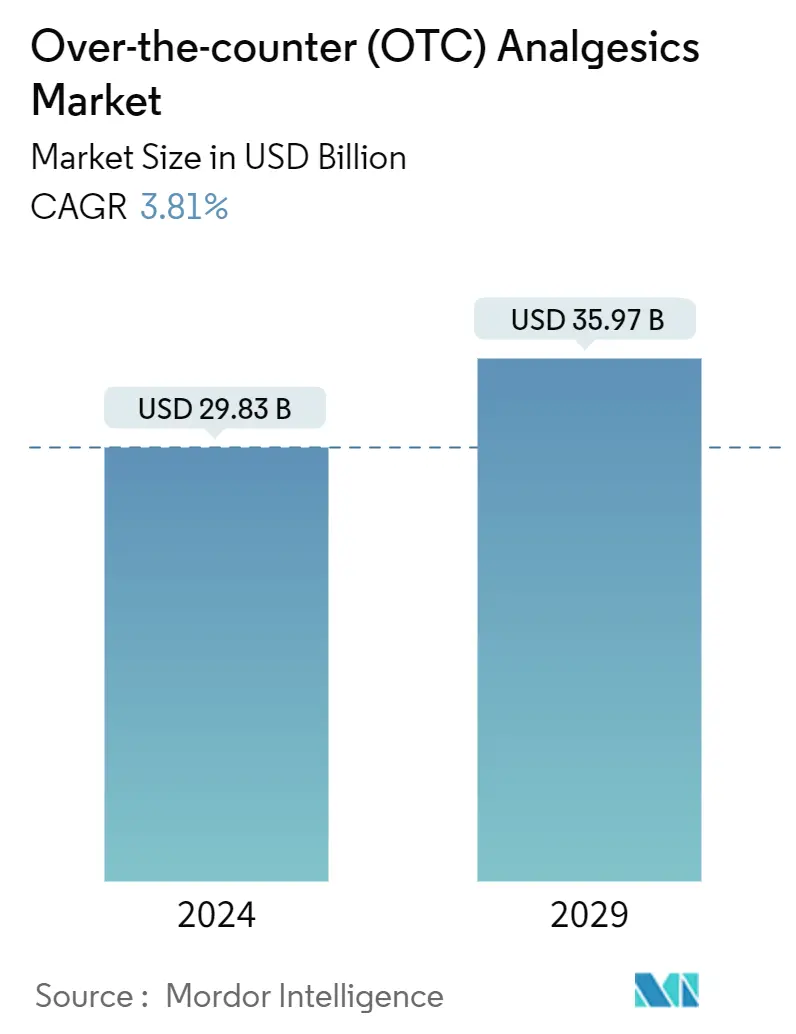Market Size of Over-the-counter (OTC) Analgesics Industry

| Study Period | 2019 - 2029 |
| Market Size (2024) | USD 29.83 Billion |
| Market Size (2029) | USD 35.97 Billion |
| CAGR (2024 - 2029) | 3.81 % |
| Fastest Growing Market | Asia-Pacific |
| Largest Market | North America |
| Market Concentration | Medium |
Major Players
*Disclaimer: Major Players sorted in no particular order |
Over-the-counter (OTC) Analgesics Market Analysis
The Over-the-counter Analgesics Market size is estimated at USD 29.83 billion in 2024, and is expected to reach USD 35.97 billion by 2029, growing at a CAGR of 3.81% during the forecast period (2024-2029).
The COVID-19 pandemic affected the OTC market globally. The demand for cold and cough OTC drugs was already high, and dietary supplements were expected to have a higher growth rate, mainly due to the COVID-19 pandemic. For instance, an article published by the Annals of Medicine and Surgery Journal in May 2022 reported that the most common OTC drugs used during the COVID-19 pandemic were antipyretics (acetaminophen, ibuprofen), antihistamines (cetirizine, loratadine), a cough suppressant (dextromethorphan), vitamins B, C, D, zinc, etc.
The article also reported that the prevalence of self-medication during the COVID-19 pandemic in lower-income countries like Nigeria, Bangladesh, Peru, and Togo varied from 34% to 84% for various symptoms like fever, cough, cold, nasal congestion, and fatigue, which was considered very high. Thus, the pandemic surged the demand for OTC analgesics. However, in the current scenario, the use of OTC drugs for relieving pain or lowering a fever is expected to drive the growth of the market studied over the forecast period.
The major factors boosting the growth of the market include the increasing demand for topical analgesics, the growth of the geriatric population, the rising prevalence of various diseases, and the cost-efficiency of OTC analgesic drugs. An article published in the BioMed Central (BMC) Journal in November 2022 reported that chronic pain is a common disease for about 20% of people worldwide. The highest China Pain Health Index (CPHI) in 2020 was in Beijing. The top five provinces were Beijing (67.64 points), Shanghai (67.04 points), Zhejiang (65.74 points), Shandong (61.16 points), and Tianjin (59.99 points). Thus, such instances show that chronic pain is growing globally. As a result, the demand for OTC analgesics is expected to grow over the forecast period.
The demand for pain relief solutions is increasing due to the growing elderly population, as aged people are more prone to chronic pain. The continuous growth of the geriatric population leads to several old age problems, for which patients refrain from going to hospitals and prefer to get medications and treatment at home. For instance, an article published by Frontiers in Human Neuroscience in March 2022 reported that organ dysfunction and other chronic diseases in the geraitric population could significantly lead to chronic pain. Thus, such factors lead to the growing importance and adoption of basic analgesic OTC products in the market. These drugs have been taken for years by the elderly patient population, which keeps the OTC demand consistently high in the market.
Additionally, there is a high prevalence of self-medication among pregnant women in France. According to the research article published by the National Center for Biotechnology Information (NCBI) in January 2021, there is a very high prevalence of maternal consumption of OTC analgesics globally, which is increasing sharply. Thus, the rising prevalence of self-medication is expected to propel the overall market growth.
In addition, another article published by NCBI in November 2022 reported that the overall mean prevalence of self-medication practices in India was 53.57%. The same source stated that the awareness of the medication seems to be a major reason to practice self-medication, and the practice was noticed more among individuals from middle-lower class families, with a prevalence rate of 26.31%. Furthermore, minor ailments were the primary reason for self-medication (SM), among which headache was the most commonly reported.
Thus, due to the increasing demand for topical analgesics, the growth of the geriatric population, the rising prevalence of various diseases, and the cost efficiency of OTC analgesic drugs, the market is expected to witness high growth over the forecast period. However, drug tolerance, dependence, addiction, and abuse are expected to slow down the growth of the market over the forecast period.
Over-the-counter (OTC) Analgesics Industry Segmentation
As per the scope of this report, over-the-counter (OTC) analgesics help relieve pain or lower fever. Over-the-counter means that one can buy these medicines without a prescription. The Over-The-Counter (OTC) Analgesics Market is Segmented By The Type Of Drug (Acetaminophen, Nonsteroidal Anti-Inflammatory Drugs (NSAIDs), Salicylates, And Other Analgesics), Distribution Channel (Hospital Pharmacies, Retail Pharmacies, Online Pharmacies, And Other Distribution Channels), And Geography (North America, Europe, Asia-Pacific, Middle East And Africa, And South America). The market report also covers the estimated market sizes and trends for 17 countries across major regions globally. The report offers the market size in value terms in USD for the abovementioned segments.
| Type of Drug | |
| Acetaminophen | |
| Nonsteroidal Anti-inflammatory Drugs (NSAIDs) | |
| Salicylates | |
| Other Analgesics |
| Distribution Channel | |
| Hospital Pharmacies | |
| Retail Pharmacies | |
| Online Pharmacies | |
| Other Distribution Channels |
| Geography | ||||||||
| ||||||||
| ||||||||
| ||||||||
| ||||||||
|
Over-the-counter (OTC) Analgesics Market Size Summary
The over-the-counter analgesics market is poised for steady growth over the forecast period, driven by several key factors. The increasing demand for pain relief solutions, particularly among the elderly population, is a significant contributor to this growth. As chronic pain becomes more prevalent globally, the preference for cost-effective and accessible OTC analgesics is rising. The market is also benefiting from the growing trend of self-medication, which has been notably high during the COVID-19 pandemic, as individuals seek convenient solutions for common ailments like fever and pain. The availability of topical analgesics and the widespread use of NSAIDs for managing chronic inflammatory disorders further bolster market expansion. These factors, combined with the ongoing development and approval of new OTC products, are expected to sustain the market's upward trajectory.
Regionally, North America is anticipated to have a substantial impact on the market due to the high prevalence of musculoskeletal diseases and sports-related injuries, which drive the demand for OTC pain management solutions. The competitive landscape is characterized by the presence of numerous multinational and local players, who are actively engaging in strategies such as product launches and regional expansions to capture larger market shares. Notable companies like Bayer AG, Johnson & Johnson, and Reckitt Benckiser Group PLC are key players in this space, continuously innovating to meet consumer needs. The market's growth is also supported by regulatory approvals that enhance the availability of effective OTC products, ensuring a robust and dynamic market environment.
Over-the-counter (OTC) Analgesics Market Size - Table of Contents
-
1. MARKET DYNAMICS
-
1.1 Market Overview
-
1.2 Market Drivers
-
1.2.1 Increasing Demand for Topical Analgesics
-
1.2.2 Growing Geriatric Population along with Increasing Prevalence of Musculoskeletal Diseases
-
1.2.3 Cost Efficiency of OTC Analgesic Drugs
-
-
1.3 Market Restraints
-
1.3.1 Drug Tolerance, Dependence, Addiction, and Abuse
-
-
1.4 Porter's Five Forces Analysis
-
1.4.1 Threat of New Entrants
-
1.4.2 Bargaining Power of Buyers/Consumers
-
1.4.3 Bargaining Power of Suppliers
-
1.4.4 Threat of Substitute Products
-
1.4.5 Intensity of Competitive Rivalry
-
-
-
2. MARKET SEGMENTATION (Market Size by Value - USD)
-
2.1 Type of Drug
-
2.1.1 Acetaminophen
-
2.1.2 Nonsteroidal Anti-inflammatory Drugs (NSAIDs)
-
2.1.3 Salicylates
-
2.1.4 Other Analgesics
-
-
2.2 Distribution Channel
-
2.2.1 Hospital Pharmacies
-
2.2.2 Retail Pharmacies
-
2.2.3 Online Pharmacies
-
2.2.4 Other Distribution Channels
-
-
2.3 Geography
-
2.3.1 North America
-
2.3.1.1 United States
-
2.3.1.2 Canada
-
2.3.1.3 Mexico
-
-
2.3.2 Europe
-
2.3.2.1 Germany
-
2.3.2.2 United Kingdom
-
2.3.2.3 France
-
2.3.2.4 Italy
-
2.3.2.5 Spain
-
2.3.2.6 Rest of Europe
-
-
2.3.3 Asia-Pacific
-
2.3.3.1 China
-
2.3.3.2 Japan
-
2.3.3.3 India
-
2.3.3.4 Australia
-
2.3.3.5 South Korea
-
2.3.3.6 Rest of Asia-Pacific
-
-
2.3.4 Middle East and Africa
-
2.3.4.1 GCC
-
2.3.4.2 South Africa
-
2.3.4.3 Rest of Middle East and Africa
-
-
2.3.5 South America
-
2.3.5.1 Brazil
-
2.3.5.2 Argentina
-
2.3.5.3 Rest of South America
-
-
-
Over-the-counter (OTC) Analgesics Market Size FAQs
How big is the Over-the-counter Analgesics Market?
The Over-the-counter Analgesics Market size is expected to reach USD 29.83 billion in 2024 and grow at a CAGR of 3.81% to reach USD 35.97 billion by 2029.
What is the current Over-the-counter Analgesics Market size?
In 2024, the Over-the-counter Analgesics Market size is expected to reach USD 29.83 billion.

